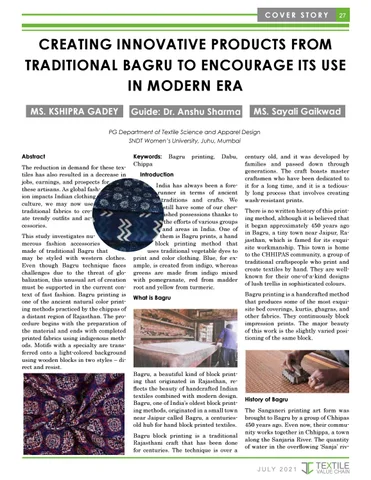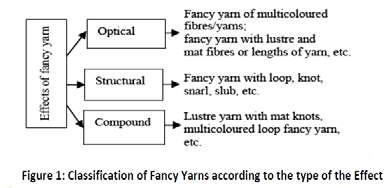C O V E R ST O R Y
27
CREATING INNOVATIVE PRODUCTS FROM TRADITIONAL BAGRU TO ENCOURAGE ITS USE IN MODERN ERA MS. KSHIPRA GADEY
Guide: Dr. Anshu Sharma
MS. Sayali Gaikwad
PG Department of Textile Science and Apparel Design SNDT Women’s University, Juhu, Mumbai Abstract The reduction in demand for these textiles has also resulted in a decrease in jobs, earnings, and prospects for these artisans. As global fashion impacts Indian clothing culture, we may now use traditional fabrics to create trendy outfits and accessories. This study investigates numerous fashion accessories made of traditional Bagru that may be styled with western clothes. Even though Bagru technique faces challenges due to the threat of globalization, this unusual art of creation must be supported in the current context of fast fashion. Bagru printing is one of the ancient natural color printing methods practiced by the chippas of a distant region of Rajasthan. The procedure begins with the preparation of the material and ends with completed printed fabrics using indigenous methods. Motifs with a specialty are transferred onto a light-colored background using wooden blocks in two styles – direct and resist.
Keywords: Chippa
Bagru
printing,
Dabu,
Introduction India has always been a forerunner in terms of ancient traditions and crafts. We still have some of our cherished possessions thanks to the efforts of various groups and areas in India. One of them is Bagru prints, a hand block printing method that uses traditional vegetable dyes to print and color clothing. Blue, for example, is created from indigo, whereas greens are made from indigo mixed with pomegranate, red from madder root and yellow from turmeric. What is Bagru
Bagru, a beautiful kind of block printing that originated in Rajasthan, reflects the beauty of handcrafted Indian textiles combined with modern design. Bagru, one of India’s oldest block printing methods, originated in a small town near Jaipur called Bagru, a centuriesold hub for hand block printed textiles. Bagru block printing is a traditional Rajasthani craft that has been done for centuries. The technique is over a
century old, and it was developed by families and passed down through generations. The craft boasts master craftsmen who have been dedicated to it for a long time, and it is a tediously long process that involves creating wash-resistant prints. There is no written history of this printing method, although it is believed that it began approximately 450 years ago in Bagru, a tiny town near Jaipur, Rajasthan, which is famed for its exquisite workmanship. This town is home to the CHHIPAS community, a group of traditional craftspeople who print and create textiles by hand. They are wellknown for their one-of-a-kind designs of lush trellis in sophisticated colours. Bagru printing is a handcrafted method that produces some of the most exquisite bed coverings, kurtis, ghagras, and other fabrics. They continuously block impression prints. The major beauty of this work is the slightly varied positioning of the same block.
History of Bagru The Sanganeri printing art form was brought to Bagru by a group of Chhipas 450 years ago. Even now, their community works together in Chhippa, a town along the Sanjaria River. The quantity of water in the overflowing ‘Sanja’ riv-
J U LY 2 0 2 1



















